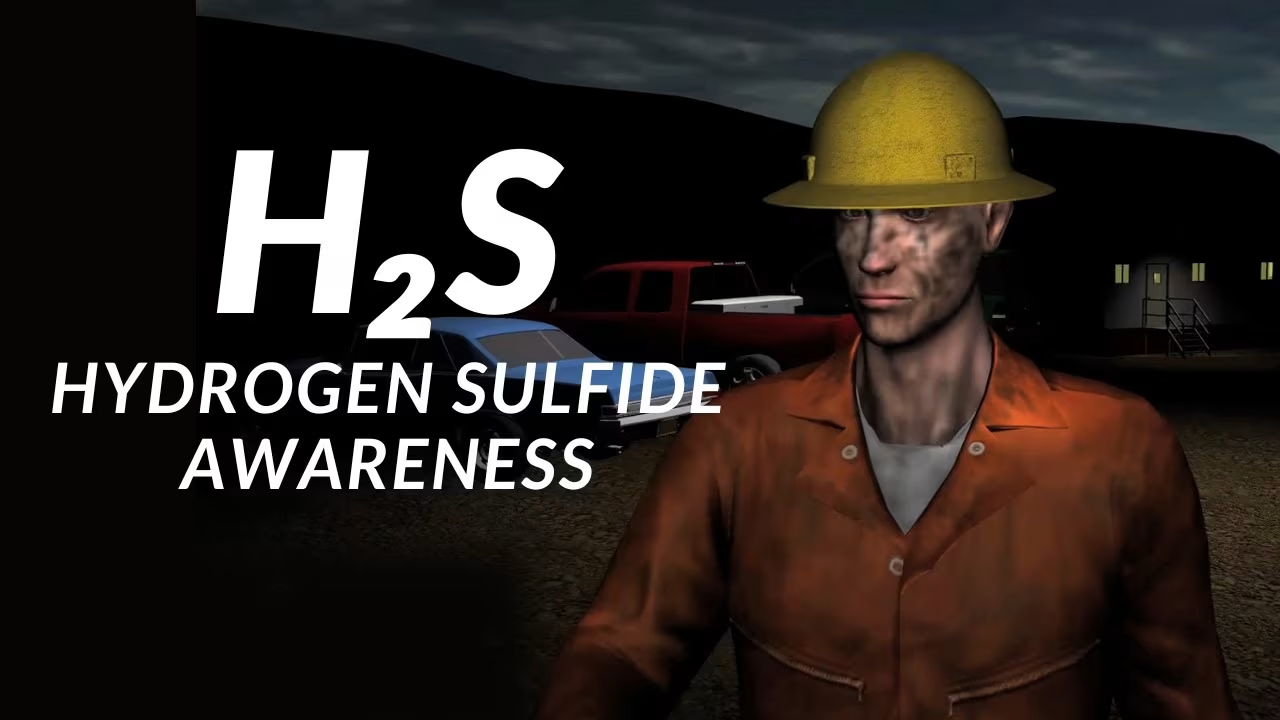
Hydrogen Sulfide Safety Training Video for UAE Oilfields Compliance
The United Arab Emirates (UAE) is a global powerhouse in the oil and gas industry, but its oilfields face significant risks from hydrogen sulfide (H₂S), a toxic and flammable gas. A hydrogen sulfide safety training video is critical for educating workers about H₂S hazards and ensuring compliance with ADNOC standards. Known as the “silent killer,” H₂S can cause severe health effects, including respiratory failure and death, even at low concentrations. This guide explores why hydrogen sulfide safety training videos are essential for mitigating H₂S risks in UAE oilfields, enhancing worker safety, and meeting regulatory requirements through engaging, visual content.
Understanding Hydrogen Sulfide Hazards in UAE Oilfields
What is Hydrogen Sulfide (H₂S)?
Hydrogen sulfide is a colorless, flammable gas with a “rotten egg” odor, commonly released during oil and gas operations. In UAE oilfields, H₂S is prevalent in sour gas fields, making hydrogen sulfide safety training videos vital for worker awareness.
Key Characteristics:
-
Toxicity: Exposure to 100 ppm can cause loss of smell, while 700+ ppm can be fatal within minutes.
-
Flammability: H₂S has a lower explosive limit of 4.3%, posing fire risks.
-
Odor Detection: Detectable at low levels (0.1–1 ppm), but higher concentrations paralyze the olfactory nerve.
H₂S Risks in UAE Oilfields
UAE oilfields, such as ADNOC’s Al Dhafra and Bu Hasa fields, often encounter H₂S during:
-
Drilling: Gas releases from sour crude reservoirs.
-
Maintenance: Pipeline repairs exposing trapped H₂S.
-
Refining: Byproduct in gas processing plants.
Health Effects:
-
Low Exposure (1–10 ppm): Eye irritation, nausea.
-
Moderate Exposure (50–100 ppm): Dizziness, respiratory distress.
-
High Exposure (500+ ppm): Unconsciousness, death.
Incident Risks: Globally, H₂S causes dozens of fatalities annually, underscoring the need for hydrogen sulfide safety training videos to prevent incidents in UAE oilfields.
UAE Regulatory Framework
The UAE enforces strict safety standards, aligned with international guidelines:
-
ADNOC HSE Policies: Mandate H₂S training, PPE, and gas detection.
-
UAE Federal Law No. 8 of 1980: Requires workplace safety training.
-
OSHA Standards (Reference): UAE companies adopt OSHA’s 20 ppm permissible exposure limit (29 CFR 1910.1000).
-
NFPA 56: Guides flammable gas handling and emergency response.
Non-compliance risks fines, shutdowns, and reputational damage, making hydrogen sulfide safety training videos essential for regulatory adherence.
Why Hydrogen Sulfide Safety Training Videos Are Critical
Hydrogen sulfide safety training videos are a powerful tool for educating oilfield workers, offering visual, engaging, and scalable content to ensure safety and compliance. Here’s why they are indispensable.
Communicating H₂S Hazards with Hydrogen Sulfide Safety Training Videos
H₂S hazards are complex, involving gas detection, PPE, and emergency protocols. Hydrogen sulfide safety training videos simplify these concepts by:
-
Visualizing Risks: Showing H₂S leaks in 3D animations of oilfield scenarios.
-
Demonstrating Procedures: Illustrating gas detector use or SCBA donning.
-
Example: A hydrogen sulfide safety training video can depict a drilling rig leak, highlighting safe zones and evacuation routes.
Benefit: Visual learning enhances comprehension, especially for diverse workforces.
Enhancing Worker Engagement Through Safety Training Videos
Traditional training methods (e.g., manuals) can be ineffective. Hydrogen sulfide safety training videos engage workers by:
-
Storytelling: Using narratives, like a worker surviving an H₂S incident, to make training relatable.
-
Interactivity: Including quizzes or clickable scenarios (e.g., “Select correct PPE”).
-
Multilingual Support: Offering Arabic, English, Hindi, and Urdu subtitles for UAE’s workforce.
Benefit: Engaged workers retain critical H₂S safety information, reducing risks.
Ensuring ADNOC Compliance with Hydrogen Sulfide Safety Training Videos
Hydrogen sulfide safety training videos help meet UAE and international standards by:
-
Documenting Training: Videos serve as audit-proof training records.
-
Covering Regulations: Addressing ADNOC HSE, OSHA’s 20 ppm PEL, and NFPA 56 requirements.
-
Example: A video showing evacuation protocols ensures compliance with UAE Federal Law No. 8.
Benefit: Videos reduce non-compliance penalties and enhance audit readiness.
Supporting Remote Training in UAE Oilfields
Remote oilfields like Habshan pose logistical challenges. Hydrogen sulfide safety training videos offer:
-
Accessibility: Viewable on mobile devices or VR headsets.
-
On-Demand Learning: Workers review content before high-risk tasks.
-
Example: A 5-minute hydrogen sulfide safety training video refreshes knowledge for drilling crews.
Benefit: Flexible training ensures safety across remote sites.
Simulating H₂S Scenarios Safely
Real-world H₂S training is dangerous. Hydrogen sulfide safety training videos provide:
-
Virtual Simulations: 3D animations of H₂S leaks or rescues.
-
Emergency Drills: Safe practice of evacuation or first aid.
-
Example: A video showing a worker collapsing from H₂S, followed by a rescue, reinforces protocols.
Benefit: Safe simulations prepare workers for emergencies without risks.
Cost-Effective Training Solutions
Hydrogen sulfide safety training videos are a one-time investment with long-term benefits:
-
Cost Savings: Reduce in-person training costs.
-
Reusability: Updateable for new regulations or equipment.
-
Example: A video used across ADNOC sites saves on trainer fees.
Benefit: Cost-effective solutions maximize safety investments.
How to Create an Effective Hydrogen Sulfide Safety Training Video
Creating a high-quality hydrogen sulfide safety training video requires planning, expertise, and alignment with UAE standards. Below is a step-by-step guide.
Planning and Research for Safety Videos
-
Objectives: Focus on H₂S detection, PPE, and emergency response.
-
Consult Experts: Collaborate with HSE officers and engineers.
-
Data Collection: Gather oilfield layouts and H₂S scenarios.
-
Audience: Address UAE’s multilingual workforce.
Tips:
-
Storyboard key scenes (e.g., H₂S leak response).
-
Reference ADNOC HSE and OSHA standards.
Choosing Animation or Live-Action for H₂S Training
-
3D Animation: Ideal for simulating leaks (e.g., Blender, Maya).
-
Live-Action: Shows PPE usage or real-world procedures.
-
Hybrid: Combines animation for risks and live-action for demonstrations.
Tips:
-
Use animation for dangerous scenarios.
-
Film live-action in controlled environments.
Developing a Script and Storyboard
-
Script: Cover H₂S hazards, detection, PPE, and emergency procedures.
-
Storyboard: Sketch scenes like gas detection or evacuation.
-
Multilingual: Include Arabic and English voiceovers.
Tips:
-
Keep videos 5–10 minutes for engagement.
-
Use simple language for accessibility.
Creating Visuals for Hydrogen Sulfide Safety Training Videos
-
Modeling: Build 3D models of rigs and safety equipment in Blender.
-
Animation: Animate H₂S leaks or worker responses.
-
Texturing: Apply realistic oilfield textures (e.g., desert terrain).
Tips:
-
Use UAE oilfield photos for accuracy.
-
Optimize models for faster rendering.
Adding Audio and Narration
-
Voiceover: Record in Audacity with professional actors.
-
Sound Effects: Use Freesound.org for alarms or machinery sounds.
-
Music: Subtle, royalty-free tracks from YouTube Audio Library.
Tips:
-
Prioritize clear narration.
-
Balance audio levels for clarity.
Editing and Polishing the Video
-
Software: DaVinci Resolve or Adobe Premiere Pro.
-
Annotations: Add text (e.g., “H₂S PEL: 20 ppm”).
-
Interactivity: Include quizzes for digital platforms.
Tips:
-
Use simple transitions (fades, cuts).
-
Export test versions for review.
Optimizing and Distributing the Video
-
Resolution: 1920×1080 for clarity.
-
Format: MP4 with H.264 codec.
-
Distribution: Host on LMS, Vimeo, or USB drives for remote sites.
Tips:
-
Compress with HandBrake (50–200 MB).
-
Test on mobile and VR devices.
Updating and Maintaining Training Videos
-
Updates: Revise for new ADNOC regulations.
-
Feedback: Collect worker input for improvements.
-
Archiving: Store master files in ProRes.
Tips:
-
Schedule annual updates.
-
Use modular assets for easy edits.
Best Practices for Hydrogen Sulfide Safety Training Videos
-
Clarity: Ensure clear visuals and narration for H₂S risks.
-
Compliance: Align with ADNOC, OSHA, and NFPA standards.
-
Engagement: Use storytelling and multilingual support.
-
Conciseness: Keep videos 5–10 minutes.
-
Testing: Pilot with workers for effectiveness.
-
Collaboration: Work with animators (e.g., Chasing Illusions Studio) and HSE experts.
Tools and Resources
-
Animation Software: Blender, Maya, Unreal Engine.
-
Editing Software: DaVinci Resolve, Adobe Premiere Pro.
-
Audio: Freesound.org, YouTube Audio Library.
-
Tutorials: Blender Guru, CG Cookie, Udemy.
-
Regulatory Resources: ADNOC.ae, OSHA.gov, NFPA.org.
-
Communities: Reddit’s r/animation, Blender Artists.
Challenges and Solutions
-
Challenge: Language barriers.
-
Solution: Multilingual subtitles or voiceovers.
-
-
Challenge: Production costs.
-
Solution: Use free tools like Blender.
-
-
Challenge: Regulatory updates.
-
Solution: Modular video designs.
-
-
Challenge: Remote worker engagement.
-
Solution: Mobile and VR accessibility.
-
Hydrogen sulfide safety training videos are vital for protecting UAE oilfield workers from H₂S risks. By communicating hazards, ensuring compliance, and engaging diverse teams, these videos foster a culture of safety. Using tools like Blender, companies can create effective, scalable training solutions. As the UAE’s oil industry grows in 2025, prioritizing hydrogen sulfide safety training videos is a lifesaving necessity.

